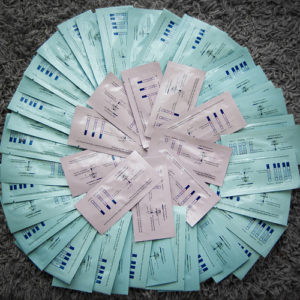For those who are entering the world of trying to conceive, or for those beginning to get to know their own body, knowing when to start ovulation testing is essential! That’s why I created a fertility chart so you can know exactly which day of your cycle to start taking ovulation tests. This fertility chart is suitable for both regular and irregular cycles, as long as it is still possible to detect the fertile window even before ovulation occurs. So how about understanding this little calculation in more detail?

We know that in a normal or so-called typical 28-day cycle, ovulation would occur exactly in the middle of the cycle, on day 14. However, since not all women have such regular cycles, the fertility chart can be very helpful. For example:
Women with 30-day cycles: The most fertile day would be the 16th day. However, fertility tests should be started on the 13th day of the cycle to monitor the evolution of the line guided by LH hormones.
Women with 21-day cycles: The early ovulation of these short cycles means that fertility tests should start on the 6th day of the cycle, to detect ovulation when the ovulatory peak would occur on the 8th day of the cycle.
For irregular cycles, the woman should take the average duration of her last 3 cycles. Let’s say the longest was 43 days and the shortest was 30 days. She should consider her fertile window from the 13th to the 25th day of the cycle. Tests should be started from the 13th, 14th, or 15th day of the cycle to monitor the rise of LH in the body. As this involves monitoring for more than 10 days with daily fertility tests, this woman should have a slightly larger stock of ovulation tests than a woman with regular cycles, or she can use other methods such as tracking basal temperature, which will also help to detect the most fertile days. Although the chart is very useful, it’s worth remembering that your cycle is not always a strict rule—even for women with theoretically regular cycles, the fertile period can change! It could be a few days longer or shorter, but it’s possible. That’s why it’s always recommended to pay attention to your body and start testing as soon as the first signs of ovulation appear.
Fertility Chart for Regular or Irregular Cycles
| Cycle Length | When to Start Testing |
| 21 Days | Day 06 |
| 22 Days | Day 06 |
| 23 Days | Day 07 |
| 24 Days | Day 07 |
| 25 Days | Day 08 |
| 26 Days | Day 09 |
| 27 Days | Day 10 |
| 28 Days | Day 11 |
| 29 Days | Day 12 |
| 30 Days | Day 13 |
| 31 Days | Day 14 |
| 32 Days | Day 15 |
| 33 Days | Day 16 |
| 34 Days | Day 17 |
| 35 Days | Day 18 |
| 36 Days | Day 19 |
| 37 Days | Day 20 |
| 38 Days | Day 21 |
| 39 Days | Day 22 |
| 40 Days | Day 23 |
These tests work perfectly well, since the basis for the conception calendar is the LH ovulatory peaks. This hormone is responsible for the ovulation itself and is detected by fertility and ovulation tests. The darker the line, the closer the woman is to her most fertile day.
Before releasing the egg, the body makes the LH peak rise, and this is considered positive in the ovulation test when the test line is equal to or even darker than the control line. The darker it is, the closer ovulation is to happening. We can say that ovulation will occur within 12 to 48 hours. That’s why taking the tests in advance is so important. The fertility chart indicates the day a woman should start testing to avoid missing the hormonal peak, and as a consequence, missing ovulation altogether.
The best time of day to take an ovulation test without missing the LH peak is in the afternoon! Contrary to what many women think, the period between 4pm and 7pm is the best for detecting fertility hormones—in this case, LH. It is not recommended to test before 12 noon, as hormonal levels are often very low at that time.
The peak happens exactly in the afternoon. It’s important to note that women using ovulation inducers might experience a longer LH peak or may not see very dark lines on their tests. Remember, the fertility chart will work better for regular cycles, but it can also work well for irregular cycles. Don’t forget to calculate the average of your last 3 cycles to determine your fertile period and the days you should start using fertility tests, and always remember your cycle may change from one cycle to another within a single year.











